
Icknield Street School, near the Hockley Flyover, north of the Jewellery Quarter, Birmingham, England, is a good example of a Birmingham board school.
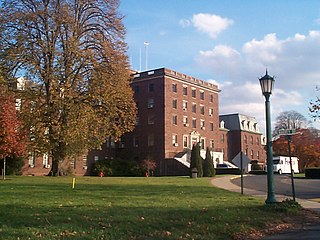
Connecticut Valley Hospital in Middletown, Connecticut, is a public hospital operated by the state of Connecticut to treat people with mental illness. It was historically known as Connecticut General Hospital for the Insane. It is a 100-acre (40 ha) historic district that was listed on the National Register of Historic Places in 1985.
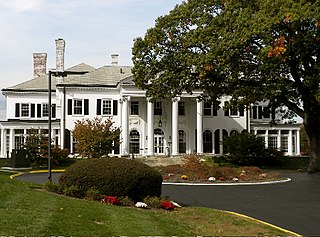
The Prospect Hill Historic District is an irregularly-shaped 185-acre (75 ha) historic district in New Haven, Connecticut. The district encompasses most of the residential portion of the Prospect Hill neighborhood.

The Whitney Avenue Historic District is a historic district in the East Rock neighborhood of New Haven, Connecticut. It is a 203-acre (82 ha) district which included 1,084 contributing buildings when it was listed on the National Register of Historic Places in 1989.

The Bradlee School is a historic former school build at 147 Andover Street in the Ballardvale section of Andover, Massachusetts, United States. The school was built by the town in 1890, and is a fine period example of Queen Anne styling, with a tall hipped roof, rounded windows on the first floor, and decorative brick details. It was listed on the National Register of Historic Places in 1982.

English High School is an historic high school building at 20 Irving Street in Worcester, Massachusetts. Built in 1891, it is a prominent local example of Romanesque Revival architecture, designed by the local form of Barker & Nourse. It served the city as a high school until 1966, and has housed school administration offices since then. The building was listed on the National Register of Historic Places in 1980.

The Dwight Street Historic District is an irregularly shaped 135-acre (55 ha) historic district in New Haven, Connecticut. The district is located immediately west of the center of Downtown New Haven and is generally bounded by Elm Street on the north, Park Street on the east, North Frontage Road on the south, and Sherman Avenue on the west. It contains one of the city's highest concentrations of well-preserved 19th and early 20th-century residential architecture, much of which was developed for the working classes in the city's factories. It was listed on the National Register of Historic Places in 1983. The historic district includes most of the Dwight neighborhood and several blocks of the northeast corner of the West River neighborhood.

Aldrich Free Public Library is the public library of the Moosup section of Plainfield, Connecticut. It is located at 299 Main Street, in an architecturally significant Queen Anne building constructed in 1895 with funds given by the library's major benefactors, David L. Aldrich and Edwin Milner. The building was listed on the National Register of Historic Places in 1994.

Union Church, also known as the Union Church of New Haven Mills is a historic church at the junction of River Rd. and East Street in New Haven, Vermont. Built in 1851, it is a fine local example of Greek Revival architecture with added Queen Anne Victorian features, and one of the oldest surviving buildings in a once-thriving mill village. It was listed on the National Register of Historic Places in 2000.

Queen Anne style architecture was one of a number of popular Victorian architectural styles that emerged in the United States during the period from roughly 1880 to 1910. Popular there during this time, it followed the Eastlake style and preceded the Richardsonian Romanesque and Shingle styles.

The Greenwich Senior Center, formerly Greenwich Town Hall, is a historic municipal building at 299 Greenwich Avenue in the business district of Greenwich, Connecticut. USA. Built in 1905, it is a prominent local example of Beaux Arts architecture, and served as the town's center of government until 1977. The building was added to the National Register of Historic Places on May 21, 1987.

The John Cook House is a historic house at 35 Elm Street in New Haven, Connecticut. Built about 1807, it is one of the city's oldest surviving stone buildings, further notable for a parade of locally or statewide prominent residents. The house was listed on the National Register of Historic Places in 1983.
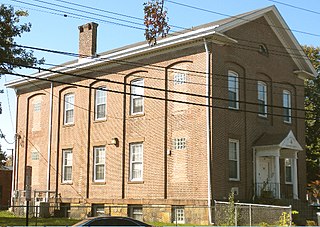
The Goffe Street Special School for Colored Children is an important landmark of African-American history at 106 Goffe Street in New Haven, Connecticut. The building, also known as Prince Hall Grand Lodge of Masons, was added to the National Register of Historic Places in 1979.
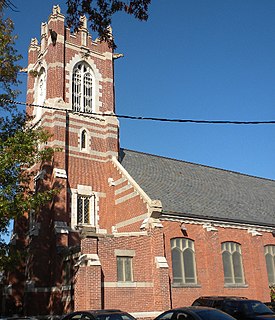
St. Luke's Episcopal Church is a historic church at 111-113 Whalley Avenue in New Haven, Connecticut. Built in 1905 for a congregation founded in 1844, it is a good example of late Gothic Revival architecture, and is further notable as the second church in the city established as an African-American congregation. It was listed on the National Register of Historic Places in 2003.
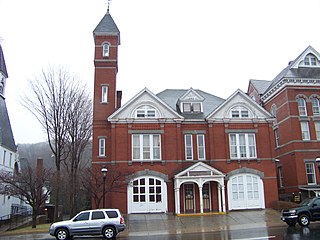
The Hose and Hook and Ladder Truck Building is a historic former firehouse on Main Street in Thomaston, Connecticut. Built in 1882, it is a fine example of Late Victorian civic architecture in brick. It was listed on the National Register of Historic Places on January 4, 1982. After serving as a firehouse for about a century, it has been converted into an art gallery.

Leoni W. Robinson was a leading architect in New Haven, Connecticut.
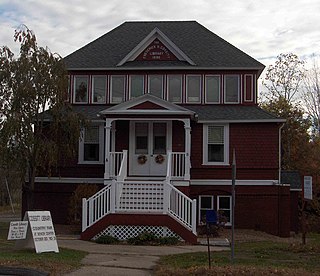
The Frederick H. Cossitt Library is a historic library building at 388 N. Granby Rd. in Granby, Connecticut. It is a Queen Anne style building, designed by Jasper Daniel Sibley and built in 1890. Construction of the library was championed by George S. Godard, later librarian of the Connecticut State Library, and was funded by a bequest from Granby native Frederick H. Cossitt, a wealthy New York businessman. It was listed on the National Register of Historic Places in 1988. It continues to serve as a branch of the town's public library system.

The J.B. Brown Memorial Block is a historic commercial building at Congress and Casco Streets in downtown Portland, Maine. Built in 1883 to a design by John Calvin Stevens, it is one of the city's few examples of Queen Anne Victorian commercial architecture. It is named in honor of John B. Brown, founder in 1855 of the Portland Sugar Company. It was listed on the National Register of Historic Places in 1978.

The Brown Tavern is a historic house and public accommodation at George Washington Turnpike and Connecticut Route 4 in Burlington, Connecticut. Probably built in the early 19th century, it is a fine example of Federal period architecture, its design tentatively credited to New Haven architect David Hoadley. Now managed by the local historical society, it was listed on the National Register of Historic Places in 1972.

The Benedict-Miller House is a historic house at 32 Hillside Avenue in Waterbury, Connecticut. Built in 1879, it is one of the city's finest surviving examples of Queen Anne architecture, designed by Palliser, Palliser & Co. for one of the city's leading industrialists. It was listed on the National Register of Historic Places in 1981. The house is now part of the campus of the Yeshiva K'tana.






















